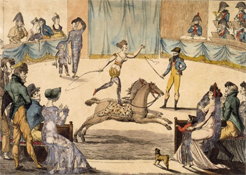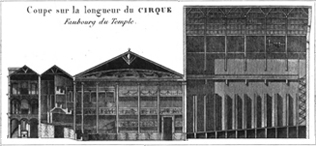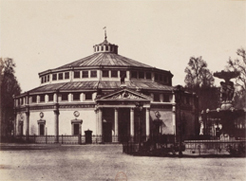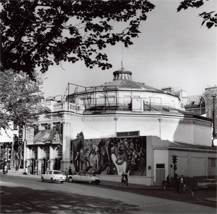A circular stage
by Christian Dupavillon
The circus was born in England from the practice of equestrian art in the late eighteenth century. In order to show their horses at a gallop, circus artists used the means the most appropriate to their purpose: a simple circular ring. No painted canvas, no arches and even less underneath; just an opening for the entry and exit of the horses. No circular edifice, ancient Greek theatre, Elizabethan theatre, or arena directly inspired these English horsemen. Although the circus traditionally travels, the "stable", permanent building has existed since its beginning. The Cirque d'Hiver in Paris, the circuses of Amiens, Reims or Elbeuf all bear witness to the glory days of these circus artists.
Sir Astley’s theatre
The idea of an equestrian theatre was that of a Sergeant Major, Philip Astley. This son of a cabinetmaker from Newcastle-under-Lyme, in Stafford County, was born in 1742. Demobilised in 1766, the model horseman decided to show off his know-how just like the other riders who exhibited their skills in parks around London. The public discovered an art hitherto reserved for the court and the army, showcasing as much the galloping horse as the prowess of his rider. In 1768, Astley rented a plot of land at a place called Half Penny Hatch in a suburb of the south bank of the Thames, in the borough of Lambeth near the Westminster Bridge, which he closed off to create a riding school at first, and where he presented his jumping exercises. He never ceased to develop his property, constructing a permanent building, the first so-called "stable" circus, that he called Astley's Amphitheatre. Two watercolours by William Capon show the facade and the interior of this amphitheatre as they were in 1777. The circular ring, open to the sky, had a diameter of 19.50 meters. A carpet or temporary stage were installed in the centre for the acrobatic and various other acts. The ring was surrounded by seating on three levels in the central building, and on a single level around the ring. Protected by a fence and despite the jets of sawdust, the spectators in the stalls could appreciate the movements of the horse more closely. Aided by the centrifugal force caused by the circle, the rider would remain in perfect balance on his horse. In 1779, Astley covered the ring with an awning to protect it from the weather.
Other horsemen opened their own establishments. In 1782, Astley’s collaborator Charles Hughes was the first to use the word Circus to baptise and brand his establishment: the walls of the Royal Circus were erected a few hundred meters from the Astley Amphitheatre. The main innovation of this new building, an improved version of Astley's simple stage, was the presence of a theatre stage with painted canvases and a backstage area, built onto ring.
Like the other English horsemen who roamed Europe, Philip Astley decided to travel. He was applauded in Dublin, Edinburgh and Paris, where in 1782 he built an amphitheatre similar to the one in London at 16 rue du Faubourg-du-Temple. From the outside, the Amphithéâtre Anglais appeared to be a simple theatre. Inside, there was an open-air ring surrounded by seating and an amphitheatre. The following year, he covered the ring, added a stage, called the establishment “L'Amphitheater des Sieurs Astley père et fils, écuyers à Londres” (The Amphitheatre of the Messers Astley Father and son, horsemen of London) and presented equestrian shows and rope dancing, from mid-October to end of February. The crowd jostled to applaud his 17-year-old son John, dancing the Devonshire minuet "with infinite grace on horses running around the ring". In 1791, the Astleys hastily left the revolutionary France. Antonio Franconi, a bird trainer originally from Veneto and the future founder of a great circus dynasty, took over the building. He undertook some renovations and notably added a stage to the ring.
The Franconi sons stayed there until the Treaty of Amiens at the end of March 1802, when the Astleys returned. While the Franconi brothers took their company on tour, their father moved first into the Enclos des Capucines, destroyed in 1806 when the rue Napoléon, currently the rue de la Paix, was built. He then transformed the riding school at the Jardin des Capucins – between the rue Saint-Honoré and the rue du Mont-Thabor, into the Cirque Olympique, the first French establishment to bear the name of "circus," in the year 1807. The mechanism was still the same: a ring, a stage and an amphitheatre. He then transformed the Jardin des Capucins riding school, between the streets of Saint-Honoré and Mont-Thabor, into the Cirque Olympique, the first French establishment in 1807 to carry the name of "circus". The same set up as always; a ring, a stage and an amphitheatre.
Expropriated at the end of the lease in 1814, they toured around France before moving back into the old Astley Amphitheater of 16 rue du Faubourg-Temple in 1816 which John Astley had left after the death of his father at the end of 1814. Several generations of artists, acrobats, musicians and pantomimes built the reputation of the establishment. The building burnt down at the end of a performance of the pantomime L’Incendie des Salins1 the night of the 15th / 16th of March 1826. A national grant enabled the construction of a new circus, at 66 Boulevard du Temple in the middle of the "Crime boulevard". The urbanisation of the district by Baron Haussmann in 1862 would sound the disappearance of the seven theatres of the Boulevard du Temple.
Adophe Franconi, the grandson of Antonio, and Louis Dejean, owner of the walls of the Boulevard du Temple, obtained the concession to a plot of land in the gardens of the Champs-Élysées, on the edge of Marigny square, where they could carry out their activities thanks to a ministerial decision on the 26th May 1835. It was an accolade, even if the building, the first circus isolated from other buildings, was made of wood and canvas.
The architect Jacques-Ignace Hittorff, who was charged with the development of the Place de la Concorde and the Champs-Elysées, built a stable circus five years later, to replace the wooden building. It would become the Cirque national de Paris (National Circus of Paris), the future Cirque de l’Impératrice (Circus of the Empress), and Cirque d'Été (Summer Circus) thereafter. This polygon with sixteen sides, measuring 42 meters from wall to wall was a reference in the circus field. The 13.5-meter-diameter ring, lit by a monumental gas chandelier was surrounded by a 4,000-seat amphitheatre. Reserved for equestrian acts only, it had no stage. Its polychrome architecture, the pedimented porch inspired by that of the Roman temple of Fortune and its famous riders attracted a wide audience. There were also concerts, and theatre plays given there. But the building became run down and was demolished in December 1899 during the construction of the 1900 World Fair.
With the shows taking place in the summer, Louis Dejean wanted a stable circus where he could present his horses during the winter. With the assurance that he would not bother the other theatres, he committed to only showing equestrian exercises. He obtained a building permit on a plot of land located at 110 rue Amelot, a few meters from Boulevard du Temple. The model was the Cirque d'été, the architect Jacques-Ignace Hittorff (1792-1867). The amphitheatre had 3,900 seats (1,600 today), the absence of intermediary poles improved visibility and six heaters heated the room. This Cirque Napoléon, inaugurated in 1852, would become the National Circus before being baptised the Cirque d'Hiver. In November 1859, Dejean innovated by using the space above the ring to present Jules Léotard’s creation the Course aux trapèzes, the ancestor of the flying trapeze. From now on the show would take place, not only in the ring, but in the air as well.
During that period, stable circuses multiplied in Paris. Circus Medrano, formerly the Circus Fernando, located at 63 Boulevard de Rochechouart, a modest copy of the Cirque d'été, opened in 1875. Less than a century later, Joseph Bouglione, its owner at the time, would demolish it and replace it with an investment property. The Nouveau Cirque, 251 rue Saint-Honoré, was renowned for the quality of its acts and its pantomimes and had 3,000 seats at its disposal for horse shows during the winter months. The summer of its first season, it served as a swimming pool thanks to a basin, 25 meters in diameter, mounted on hydraulic piston in the place of the ring and the first rows of spectator seating. It opened in 1886 and closed in 1926.
Worthy of note also was the imposing Cirque Métropole, 20 avenue de la Motte-Picquet, with its 6,000 seats arranged in height over four levels. Opened in 1906, it closed in 1930 after having been converted into a cinema and music hall. All that remains of these establishments is the Cirque d’Hiver, which was listed in the Supplementary Inventory of Historic Monuments in February 1975.
1. Show recounting the fire which, on the 27th of July 1825, completely ravaged the city of Salins-les-Bains in the Jura.




















